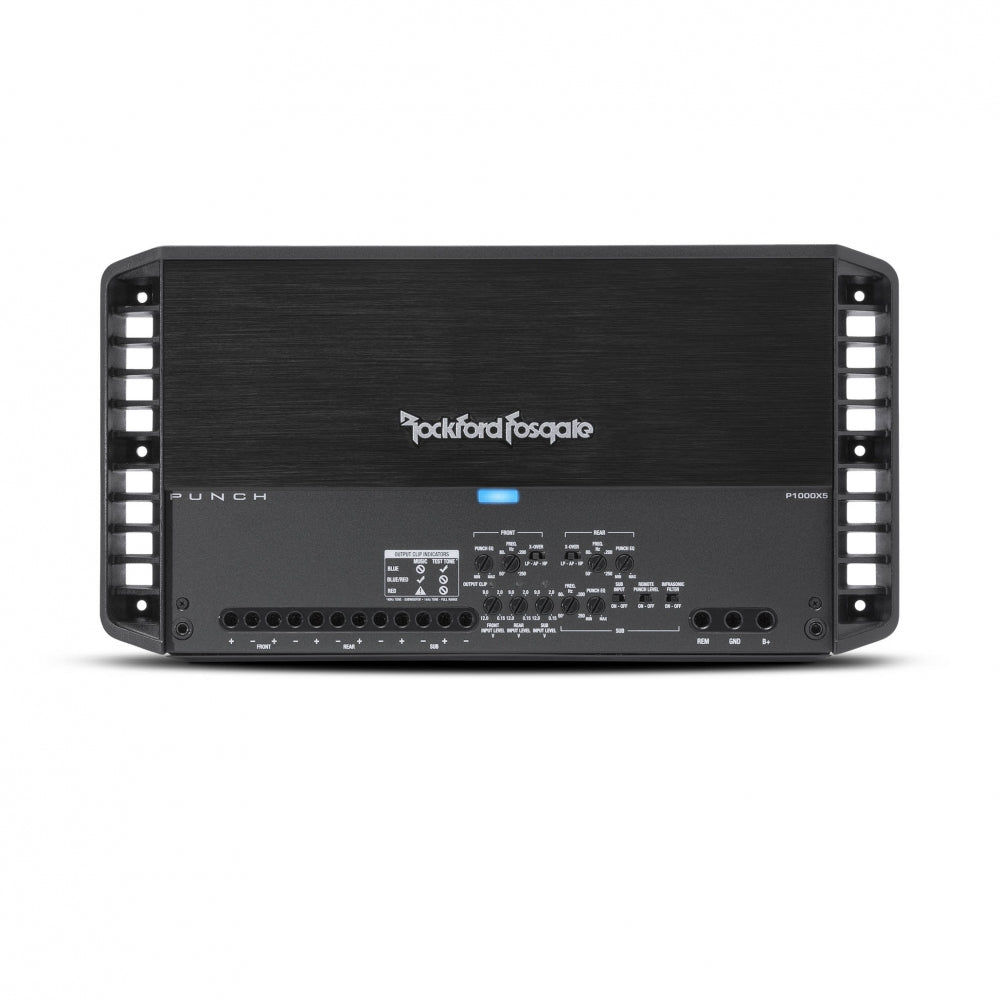Rockford Fosgate
P1000X5
P1000X5
Couldn't load pickup availability
Rockford Fosgate Punch 1000 Watt 5 Channel Amplifier
The Rockford Fosgate P1000X5 is an all-in-one solution to deliver superior sound quality, clarity, and hard hitting bass to your vehicle's stereo system. This amplifier is a beast that gives you 5 channel to power your speakers plus an additional channel for the subwoofer(s). If you are looking to upgrade your vehicle's stereo system and you one amp to handle everything, the P1000X5 is one of the best choices out there.
75W x 4 @ 4 Ohms to Power Your Speakers
The Rockford Fosgate P1000X5 puts out 75 watts RMS to each speaker at 4 ohms. This is the most common setup where each channel is powering a single, 4 ohm speaker. If you are building a larger system and you are wiring more than one speaker per channel, the P1000X5 is rated at 125 per channel at 2 ohms. The power output from this amplifier is a perfect match for virtually all car audio speakers, unless you have some expensive, high-end speakers that can really handle some power. But, if your speakers can handle between 100-125W RMS, the P1000X5 is perfect.
300W @ 2 Ohms and 500W x 1 @ 1 Ohm for the Subwoofer(s)
For the subwoofer channel, the P1000X5 puts out 300 watts at 2 Ohms and 500 watts at 1 Ohm. Many 5 channel amplifiers are not 1 Ohm stable for the subwoofer. The Rockford Fosgate P1000X5 delivers more power to the subwoofers, more efficiently because it is 1 ohm stable. This allows you to add a single subwoofer with more power handling, or you have enough power for two subwoofers. With 500 watts RMS to the subwoofer you can power a single P3 subwoofer at 1 Ohm, a pair of R2 subwoofers, a pair of P1 subwoofers, or a T1 Slim subwoofer.
C.L.E.A.N. Setup LED Clipping Indicators
This amplifier comes with Rockford's CLEAN setup technology. The CLEAN setup is an LED clipping indicator that tells you where your head unit clips (distorts) for the signal input of the amplifier and where to set the gain on the amplifier to ensure that the amplifier doesn't send a clipped signal to the speakers or subwoofer. This allows you to perfectly set your amplifier gains so that you don't get a clipped input or output signal and helps protect and extend the life of your car's stereo system.
Here's how it works. Most radios or head units have distortion at a certain volume. Before you connect your speakers, you want to get the amplifier power and connected to the head unit. Then, you play a test track and turn the volume up on the head unit until you see the LED light up. When it lights up, look at the volume level on the radio, and slowly turn it down, 1 number/notch at a time unitl the LED stops illuminating. This tells you how loud you can turn up the volume on the radio without getting a clipped signal. We don't want a clipped signal because if you have an clipped input signal, the amplifier will amplify that, and make it even worse. The spekaers don't know what to do with a clipped signal so that energy gets turned into heat/distortion, and it's all bad.
Once we know where the radio clips, we then turn up the gain on the amplifier until we see the LED turn on to tell us that we have an clipped output signal. Then, we slowly turn down the gain until the LED turn off. Now, we have maximized the gain on the amplifier without distortion.
So, in theory, if you never turn the radio above the level you noted on the input, you should never get a clipped input or output signal. We now know how loud we can turn up the stereo system without clipping and the gains are set at the optimal levels.
Works with Most Factory & Aftermarket Head Units
The P1000X5 accpets both high and low level inputs. This allows you to install this amplifier if you have a factory head unit, using the speaker level outputs from your radio. If you have an aftermarket head unit, you can use the tradtional, RCA output on the radio or you can use the speaker level inputs, whichever you prefer.
2/4 Channel & Subwoofer Input Switches
The 2/4 channel input switch allows you to run this amplifier with only 2 channels of input. The amplifier will take the input from the front channels and use that input to power the rear channels. In addition, there is a switch for the subwoofer input. So, if your head unit does not have a subwoofer pre-out, no worries. The amplifier will take the input for the full-range channels, filter the signal for the subwoofer frequencies, and send that signal to the subwoofer. Now, if you are using the high-level, speaker wire outputs from your head unit, you will need speaker wire to RCA adapters to use the RCA inputs on the amplifier.
High-Pass, Low-Pass, and Subsonic Filters @ 12dB/Octave
This amp has variable, high-pass filters for the front and rear channels between 50-250Hz at 12dB/Octave. For the subwoofer channel the P1000X5 has a variable low pass filter between 50-250Hz at 12dB/octave as well as an infrasonic filter at 28Hz.
The high pass filters on the front and rear channels allow you to say, "Don't play frequencies below this level." Now, that is not a hard line but instead slope that decreases by 12dB at every octave to ideally send your high and mid range frequencies to your speakers while leaving out the subwoofer frequencies for the subwoofer. The low-pass fitler on the subwoofer is designed to do the opposite. When you turn the filter on and set it at a specific frequency, you are telling the subwoofer "Don't play frequencies above this frequency." The same rule applies where it is not a hard stop, line in the sand, but instead a gradual roll off at 12dB per octave. The infrasonic, or subsonic filter for the subwoofer when turned on tells the subwoofer, "Don't play frequencies below 28 Hz," with the gradual roll off of the same 12dB/octave. The infrasonic filter prevents the subwoofer from going too low and getting damaged by playing frequencies that the human ear can't detect. The signal filtering is designed to have your speakers only receive and play the frequencies that they were designed to play.
Dynamic Power Rating
The Rockford Fosgate P1000X5 amplifier has a dynamic power rating that exceeds the RMS output. So, "What is the Dynamic Power Rating?" The Dynamic Power rating is a power rating that more accurately models a real world, listening environment with music. The RMS rating tells us the "constant" output of the amplifier. The dynamic rating tells us what the realistic output looks like when listening to music. The dynamic power rating of the P1000X5:
- 115W x 4 + 299W x 1 @ 4 Ohms
- 190W x 4 + 540W x 1 @ 2 Ohms
- N/A x 4 + 863W x 1 @ 1 Ohm
So for a typical stereo system that has front speakers, rear speakers, and a subwoofer, we will get 115 watts to each speaker. Now, the subwoofer will depend on the wired impedance, but this means we can get up to 863 watts of output for the subwoofer if the subwoofer is wired to a 1 Ohm load. So, even though this is a 1000 watt amplifier, the real-world, typical installation, output of the P1000X5 is 1323 watts with the speakers at 4 ohms and the subwoofer at 1 Ohm.
Other Things You Might Need
Features
- High level input capable with Auto Turn-On circuit
- Features C.L.E.A.N. Set-up
- Optional remote Punch Level Control (PLC2) ready (w/ input clip indicator)
- 12dB/octave Butterworth crossover
- On-board Punch EQ with +18dB boost @ 45Hz.
- Muted turn on
- Stealth top mounted control panel
- Cast aluminum heatsink
- Short circuit protection
- Over current protection
- Infrasonic filter
- 2/4 channel input switch
Shipping & Returns
Shipping & Returns










